CTEL/501 - Exploring Affective Factors in Second Language Learning
VerifiedAdded on 2022/09/09
|8
|1610
|15
Report
AI Summary
This report, completed for the CTEL/501 course, investigates the influence of affective factors on second language acquisition. It begins with a chart detailing various affective factors like anxiety, and their relationship to pedagogical processes and the impact of students' home culture and language. The report then reflects on classroom expectations a teacher might have, highlighting the effects of these expectations on student learning. The author discusses how they, as a teacher, would address these affective factors in the classroom, emphasizing the importance of understanding individual student needs, fostering a supportive environment, and adapting teaching strategies to accommodate diverse backgrounds. The report concludes by referencing supporting literature on the subject.

Running head: EFFECTIVE FACTORS CHART
1
Affective Factors Chart
Name
Institution
Professor
Course
Date
1
Affective Factors Chart
Name
Institution
Professor
Course
Date
Paraphrase This Document
Need a fresh take? Get an instant paraphrase of this document with our AI Paraphraser
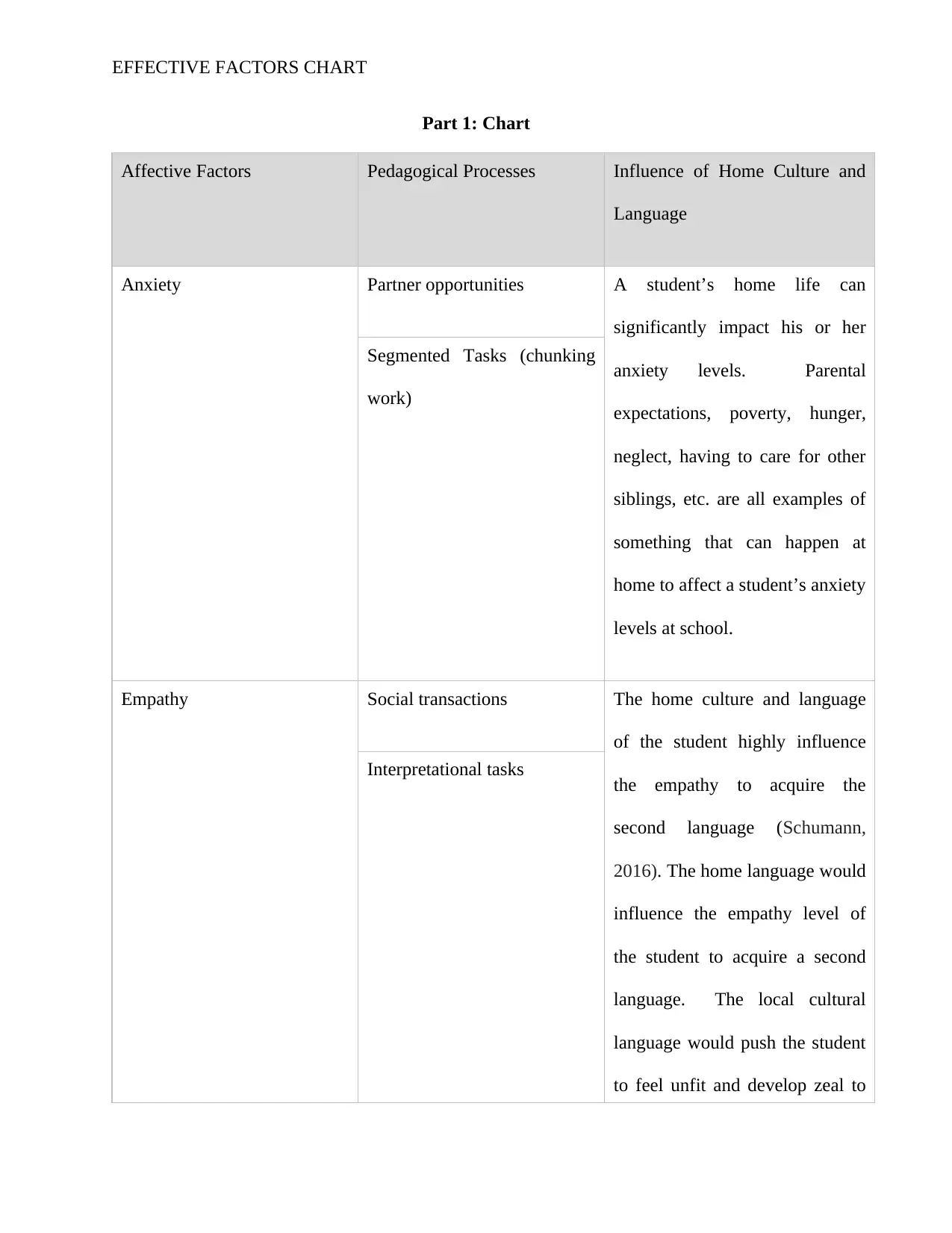
EFFECTIVE FACTORS CHART
Part 1: Chart
Affective Factors Pedagogical Processes Influence of Home Culture and
Language
Anxiety Partner opportunities A student’s home life can
significantly impact his or her
anxiety levels. Parental
expectations, poverty, hunger,
neglect, having to care for other
siblings, etc. are all examples of
something that can happen at
home to affect a student’s anxiety
levels at school.
Segmented Tasks (chunking
work)
Empathy Social transactions The home culture and language
of the student highly influence
the empathy to acquire the
second language (Schumann,
2016). The home language would
influence the empathy level of
the student to acquire a second
language. The local cultural
language would push the student
to feel unfit and develop zeal to
Interpretational tasks
Part 1: Chart
Affective Factors Pedagogical Processes Influence of Home Culture and
Language
Anxiety Partner opportunities A student’s home life can
significantly impact his or her
anxiety levels. Parental
expectations, poverty, hunger,
neglect, having to care for other
siblings, etc. are all examples of
something that can happen at
home to affect a student’s anxiety
levels at school.
Segmented Tasks (chunking
work)
Empathy Social transactions The home culture and language
of the student highly influence
the empathy to acquire the
second language (Schumann,
2016). The home language would
influence the empathy level of
the student to acquire a second
language. The local cultural
language would push the student
to feel unfit and develop zeal to
Interpretational tasks
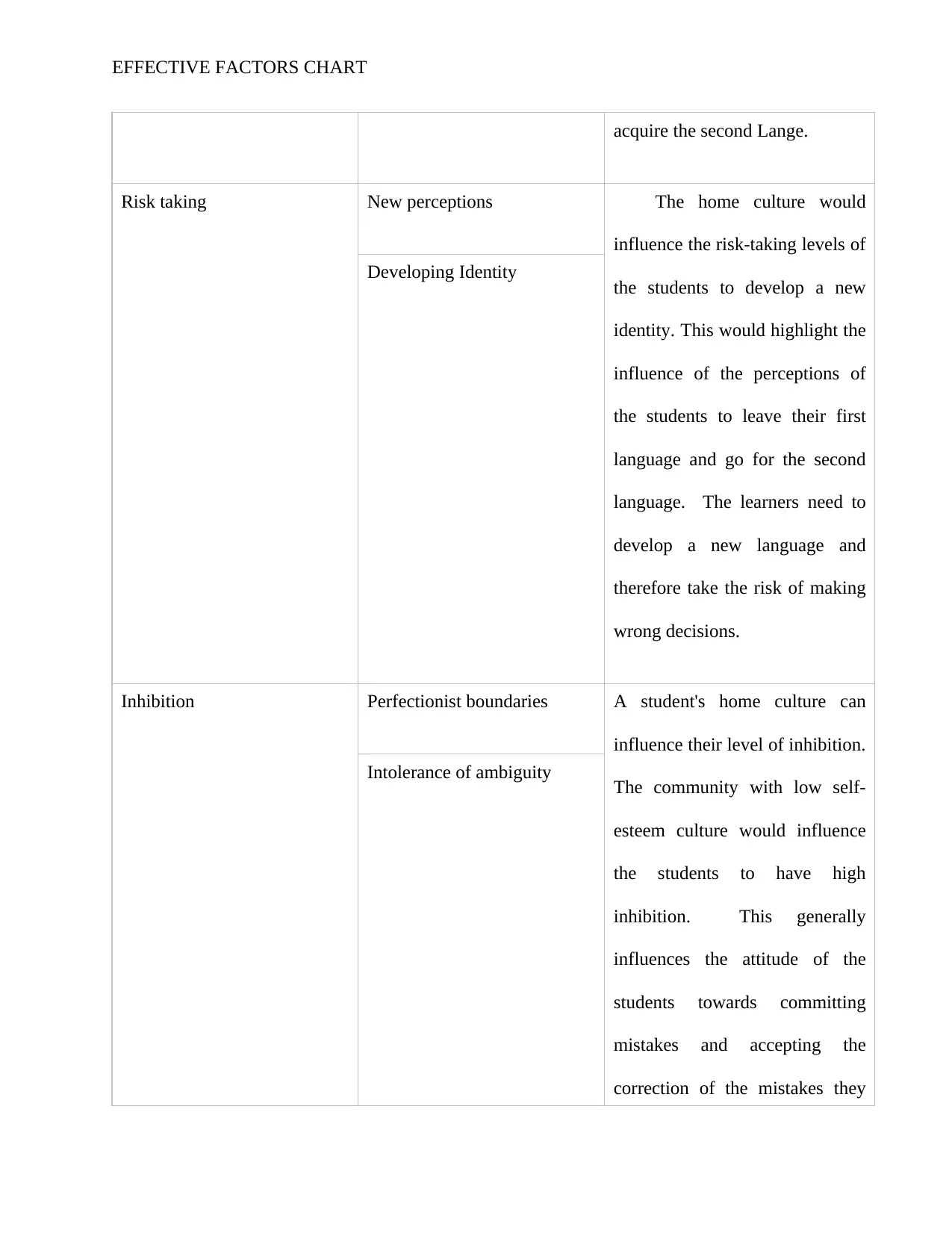
EFFECTIVE FACTORS CHART
acquire the second Lange.
Risk taking New perceptions The home culture would
influence the risk-taking levels of
the students to develop a new
identity. This would highlight the
influence of the perceptions of
the students to leave their first
language and go for the second
language. The learners need to
develop a new language and
therefore take the risk of making
wrong decisions.
Developing Identity
Inhibition Perfectionist boundaries A student's home culture can
influence their level of inhibition.
The community with low self-
esteem culture would influence
the students to have high
inhibition. This generally
influences the attitude of the
students towards committing
mistakes and accepting the
correction of the mistakes they
Intolerance of ambiguity
acquire the second Lange.
Risk taking New perceptions The home culture would
influence the risk-taking levels of
the students to develop a new
identity. This would highlight the
influence of the perceptions of
the students to leave their first
language and go for the second
language. The learners need to
develop a new language and
therefore take the risk of making
wrong decisions.
Developing Identity
Inhibition Perfectionist boundaries A student's home culture can
influence their level of inhibition.
The community with low self-
esteem culture would influence
the students to have high
inhibition. This generally
influences the attitude of the
students towards committing
mistakes and accepting the
correction of the mistakes they
Intolerance of ambiguity
⊘ This is a preview!⊘
Do you want full access?
Subscribe today to unlock all pages.

Trusted by 1+ million students worldwide
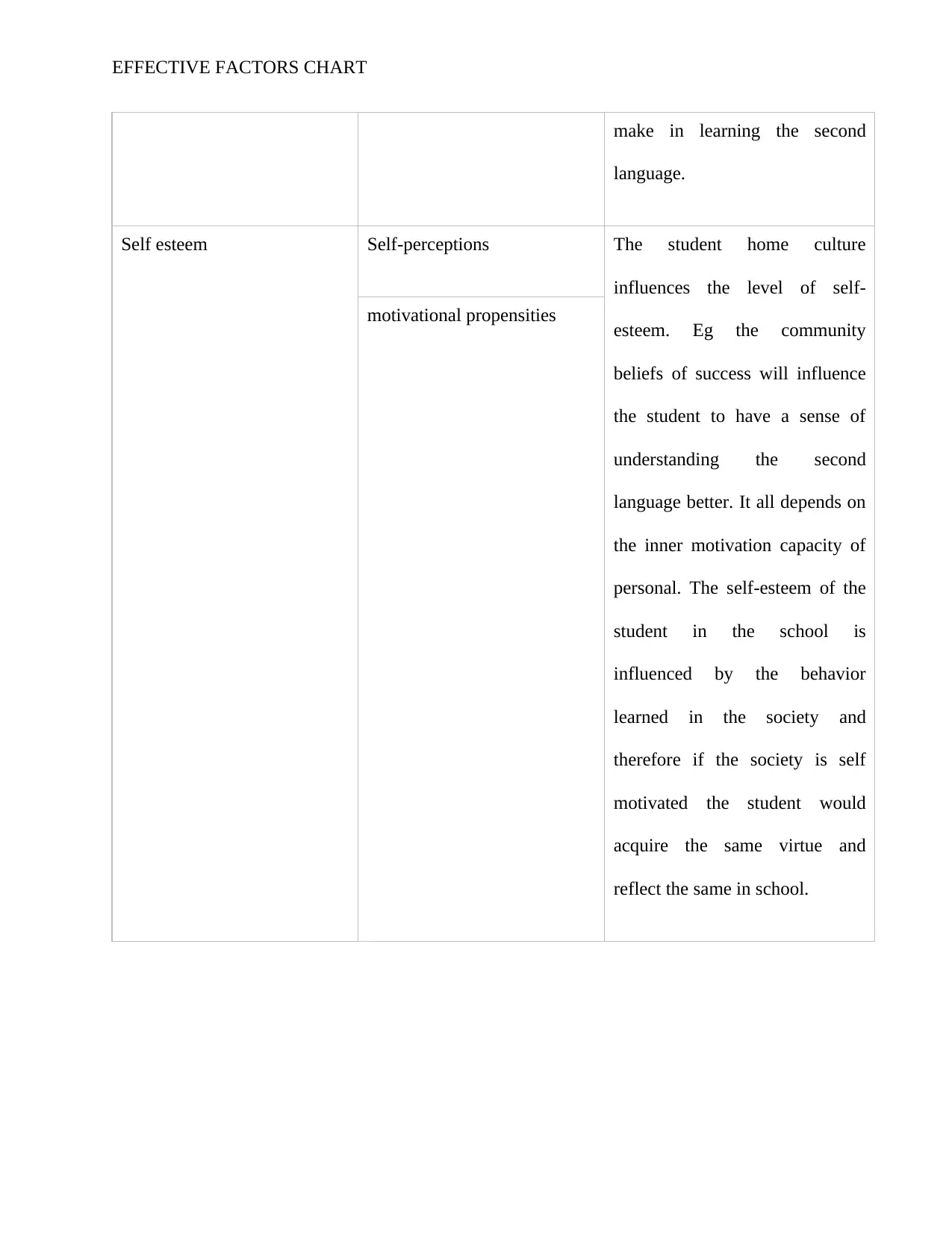
EFFECTIVE FACTORS CHART
make in learning the second
language.
Self esteem Self-perceptions The student home culture
influences the level of self-
esteem. Eg the community
beliefs of success will influence
the student to have a sense of
understanding the second
language better. It all depends on
the inner motivation capacity of
personal. The self-esteem of the
student in the school is
influenced by the behavior
learned in the society and
therefore if the society is self
motivated the student would
acquire the same virtue and
reflect the same in school.
motivational propensities
make in learning the second
language.
Self esteem Self-perceptions The student home culture
influences the level of self-
esteem. Eg the community
beliefs of success will influence
the student to have a sense of
understanding the second
language better. It all depends on
the inner motivation capacity of
personal. The self-esteem of the
student in the school is
influenced by the behavior
learned in the society and
therefore if the society is self
motivated the student would
acquire the same virtue and
reflect the same in school.
motivational propensities
Paraphrase This Document
Need a fresh take? Get an instant paraphrase of this document with our AI Paraphraser
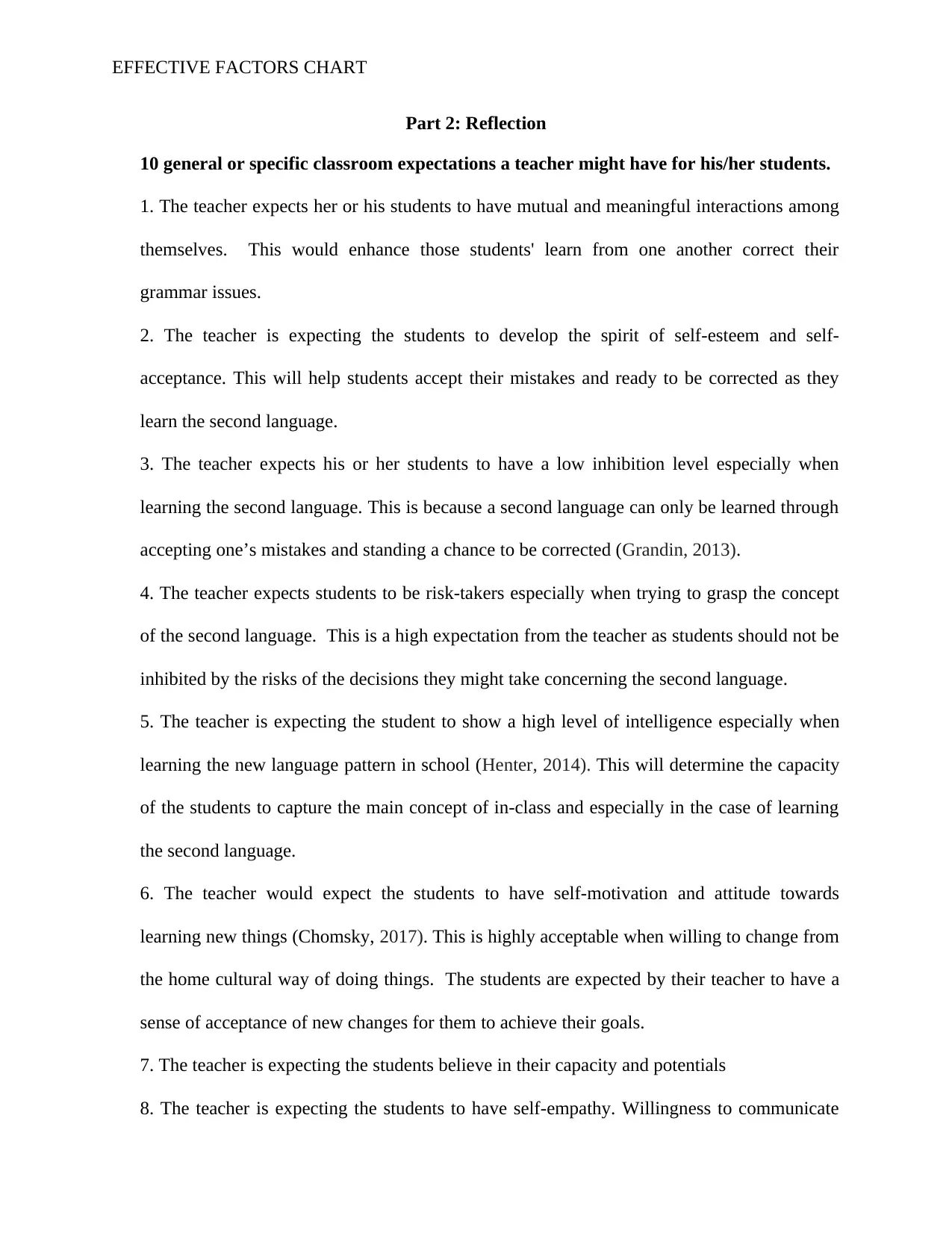
EFFECTIVE FACTORS CHART
Part 2: Reflection
10 general or specific classroom expectations a teacher might have for his/her students.
1. The teacher expects her or his students to have mutual and meaningful interactions among
themselves. This would enhance those students' learn from one another correct their
grammar issues.
2. The teacher is expecting the students to develop the spirit of self-esteem and self-
acceptance. This will help students accept their mistakes and ready to be corrected as they
learn the second language.
3. The teacher expects his or her students to have a low inhibition level especially when
learning the second language. This is because a second language can only be learned through
accepting one’s mistakes and standing a chance to be corrected (Grandin, 2013).
4. The teacher expects students to be risk-takers especially when trying to grasp the concept
of the second language. This is a high expectation from the teacher as students should not be
inhibited by the risks of the decisions they might take concerning the second language.
5. The teacher is expecting the student to show a high level of intelligence especially when
learning the new language pattern in school (Henter, 2014). This will determine the capacity
of the students to capture the main concept of in-class and especially in the case of learning
the second language.
6. The teacher would expect the students to have self-motivation and attitude towards
learning new things (Chomsky, 2017). This is highly acceptable when willing to change from
the home cultural way of doing things. The students are expected by their teacher to have a
sense of acceptance of new changes for them to achieve their goals.
7. The teacher is expecting the students believe in their capacity and potentials
8. The teacher is expecting the students to have self-empathy. Willingness to communicate
Part 2: Reflection
10 general or specific classroom expectations a teacher might have for his/her students.
1. The teacher expects her or his students to have mutual and meaningful interactions among
themselves. This would enhance those students' learn from one another correct their
grammar issues.
2. The teacher is expecting the students to develop the spirit of self-esteem and self-
acceptance. This will help students accept their mistakes and ready to be corrected as they
learn the second language.
3. The teacher expects his or her students to have a low inhibition level especially when
learning the second language. This is because a second language can only be learned through
accepting one’s mistakes and standing a chance to be corrected (Grandin, 2013).
4. The teacher expects students to be risk-takers especially when trying to grasp the concept
of the second language. This is a high expectation from the teacher as students should not be
inhibited by the risks of the decisions they might take concerning the second language.
5. The teacher is expecting the student to show a high level of intelligence especially when
learning the new language pattern in school (Henter, 2014). This will determine the capacity
of the students to capture the main concept of in-class and especially in the case of learning
the second language.
6. The teacher would expect the students to have self-motivation and attitude towards
learning new things (Chomsky, 2017). This is highly acceptable when willing to change from
the home cultural way of doing things. The students are expected by their teacher to have a
sense of acceptance of new changes for them to achieve their goals.
7. The teacher is expecting the students believe in their capacity and potentials
8. The teacher is expecting the students to have self-empathy. Willingness to communicate
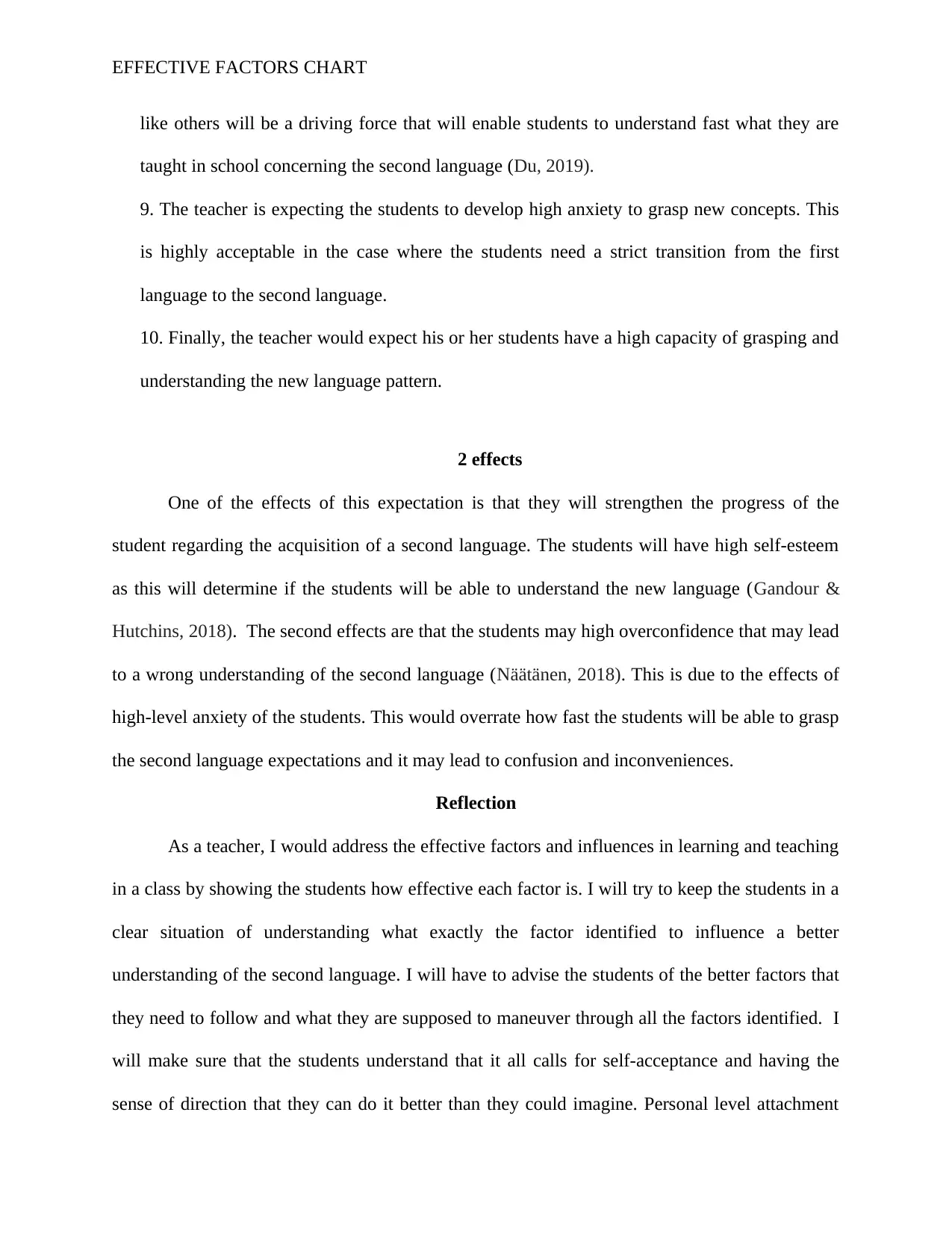
EFFECTIVE FACTORS CHART
like others will be a driving force that will enable students to understand fast what they are
taught in school concerning the second language (Du, 2019).
9. The teacher is expecting the students to develop high anxiety to grasp new concepts. This
is highly acceptable in the case where the students need a strict transition from the first
language to the second language.
10. Finally, the teacher would expect his or her students have a high capacity of grasping and
understanding the new language pattern.
2 effects
One of the effects of this expectation is that they will strengthen the progress of the
student regarding the acquisition of a second language. The students will have high self-esteem
as this will determine if the students will be able to understand the new language (Gandour &
Hutchins, 2018). The second effects are that the students may high overconfidence that may lead
to a wrong understanding of the second language (Näätänen, 2018). This is due to the effects of
high-level anxiety of the students. This would overrate how fast the students will be able to grasp
the second language expectations and it may lead to confusion and inconveniences.
Reflection
As a teacher, I would address the effective factors and influences in learning and teaching
in a class by showing the students how effective each factor is. I will try to keep the students in a
clear situation of understanding what exactly the factor identified to influence a better
understanding of the second language. I will have to advise the students of the better factors that
they need to follow and what they are supposed to maneuver through all the factors identified. I
will make sure that the students understand that it all calls for self-acceptance and having the
sense of direction that they can do it better than they could imagine. Personal level attachment
like others will be a driving force that will enable students to understand fast what they are
taught in school concerning the second language (Du, 2019).
9. The teacher is expecting the students to develop high anxiety to grasp new concepts. This
is highly acceptable in the case where the students need a strict transition from the first
language to the second language.
10. Finally, the teacher would expect his or her students have a high capacity of grasping and
understanding the new language pattern.
2 effects
One of the effects of this expectation is that they will strengthen the progress of the
student regarding the acquisition of a second language. The students will have high self-esteem
as this will determine if the students will be able to understand the new language (Gandour &
Hutchins, 2018). The second effects are that the students may high overconfidence that may lead
to a wrong understanding of the second language (Näätänen, 2018). This is due to the effects of
high-level anxiety of the students. This would overrate how fast the students will be able to grasp
the second language expectations and it may lead to confusion and inconveniences.
Reflection
As a teacher, I would address the effective factors and influences in learning and teaching
in a class by showing the students how effective each factor is. I will try to keep the students in a
clear situation of understanding what exactly the factor identified to influence a better
understanding of the second language. I will have to advise the students of the better factors that
they need to follow and what they are supposed to maneuver through all the factors identified. I
will make sure that the students understand that it all calls for self-acceptance and having the
sense of direction that they can do it better than they could imagine. Personal level attachment
⊘ This is a preview!⊘
Do you want full access?
Subscribe today to unlock all pages.

Trusted by 1+ million students worldwide

EFFECTIVE FACTORS CHART
with the students will be one of the best ways to take because though this individual student
capacity in class would be well understood. I would show the students the best ways of
evaluating their performance in classwork. This would be done by working closely together with
the student to understand each student’s influencing factors. It would be so advisable to help the
students with home and cultural influence have a better look at things in class settings. I will
have to commit fully to reach the needs of the students at their level.
I would help my students to flexible to new changes for them to learn and aquire the
class concepts easily. This will give me a rough idea of how to address the effective factors that
the students should learn and depend on in learning new skills in class. I would advise the
students on how to overcome some of the challenges caused by background situations such as
poverty, culture and social setting and show them better ways to adapt to new changes in
classwork. This will be highly influenced by the cultural home where the student comes from.
Therefore, I believe all the students will have a high level of understanding of the concepts and
new skills I would be teaching in class. In my opinion, it depends on the attention and perception
of the teacher towards the students. In this concern, equality and accepting the situation of my
students would be an effective manner to enable them to understand the effective factors that
they should follow as the manoeuver through their classwork and learning of new skills.
with the students will be one of the best ways to take because though this individual student
capacity in class would be well understood. I would show the students the best ways of
evaluating their performance in classwork. This would be done by working closely together with
the student to understand each student’s influencing factors. It would be so advisable to help the
students with home and cultural influence have a better look at things in class settings. I will
have to commit fully to reach the needs of the students at their level.
I would help my students to flexible to new changes for them to learn and aquire the
class concepts easily. This will give me a rough idea of how to address the effective factors that
the students should learn and depend on in learning new skills in class. I would advise the
students on how to overcome some of the challenges caused by background situations such as
poverty, culture and social setting and show them better ways to adapt to new changes in
classwork. This will be highly influenced by the cultural home where the student comes from.
Therefore, I believe all the students will have a high level of understanding of the concepts and
new skills I would be teaching in class. In my opinion, it depends on the attention and perception
of the teacher towards the students. In this concern, equality and accepting the situation of my
students would be an effective manner to enable them to understand the effective factors that
they should follow as the manoeuver through their classwork and learning of new skills.
Paraphrase This Document
Need a fresh take? Get an instant paraphrase of this document with our AI Paraphraser
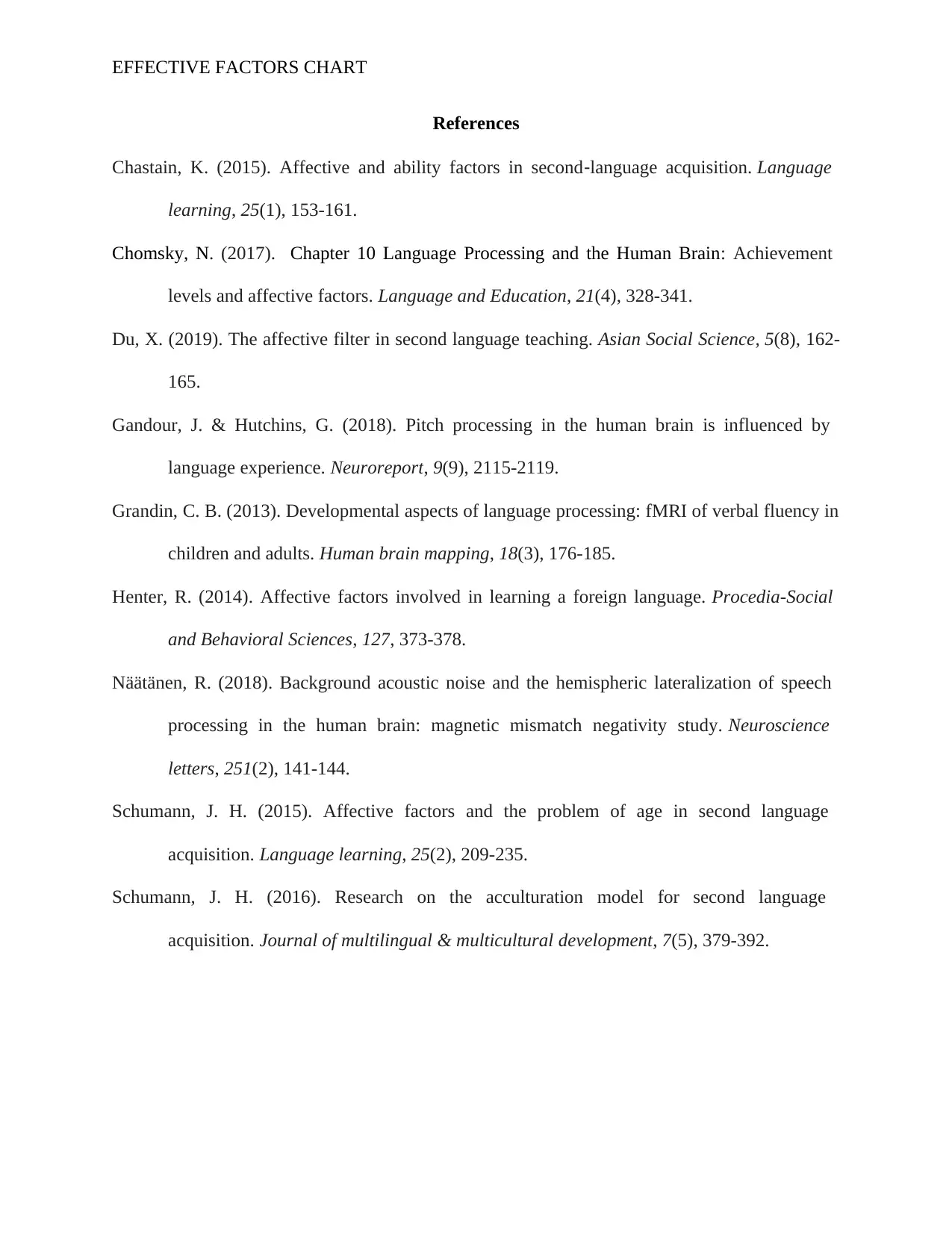
EFFECTIVE FACTORS CHART
References
Chastain, K. (2015). Affective and ability factors in second‐language acquisition. Language
learning, 25(1), 153-161.
Chomsky, N. (2017). Chapter 10 Language Processing and the Human Brain: Achievement
levels and affective factors. Language and Education, 21(4), 328-341.
Du, X. (2019). The affective filter in second language teaching. Asian Social Science, 5(8), 162-
165.
Gandour, J. & Hutchins, G. (2018). Pitch processing in the human brain is influenced by
language experience. Neuroreport, 9(9), 2115-2119.
Grandin, C. B. (2013). Developmental aspects of language processing: fMRI of verbal fluency in
children and adults. Human brain mapping, 18(3), 176-185.
Henter, R. (2014). Affective factors involved in learning a foreign language. Procedia-Social
and Behavioral Sciences, 127, 373-378.
Näätänen, R. (2018). Background acoustic noise and the hemispheric lateralization of speech
processing in the human brain: magnetic mismatch negativity study. Neuroscience
letters, 251(2), 141-144.
Schumann, J. H. (2015). Affective factors and the problem of age in second language
acquisition. Language learning, 25(2), 209-235.
Schumann, J. H. (2016). Research on the acculturation model for second language
acquisition. Journal of multilingual & multicultural development, 7(5), 379-392.
References
Chastain, K. (2015). Affective and ability factors in second‐language acquisition. Language
learning, 25(1), 153-161.
Chomsky, N. (2017). Chapter 10 Language Processing and the Human Brain: Achievement
levels and affective factors. Language and Education, 21(4), 328-341.
Du, X. (2019). The affective filter in second language teaching. Asian Social Science, 5(8), 162-
165.
Gandour, J. & Hutchins, G. (2018). Pitch processing in the human brain is influenced by
language experience. Neuroreport, 9(9), 2115-2119.
Grandin, C. B. (2013). Developmental aspects of language processing: fMRI of verbal fluency in
children and adults. Human brain mapping, 18(3), 176-185.
Henter, R. (2014). Affective factors involved in learning a foreign language. Procedia-Social
and Behavioral Sciences, 127, 373-378.
Näätänen, R. (2018). Background acoustic noise and the hemispheric lateralization of speech
processing in the human brain: magnetic mismatch negativity study. Neuroscience
letters, 251(2), 141-144.
Schumann, J. H. (2015). Affective factors and the problem of age in second language
acquisition. Language learning, 25(2), 209-235.
Schumann, J. H. (2016). Research on the acculturation model for second language
acquisition. Journal of multilingual & multicultural development, 7(5), 379-392.
1 out of 8
Related Documents
Your All-in-One AI-Powered Toolkit for Academic Success.
+13062052269
info@desklib.com
Available 24*7 on WhatsApp / Email
![[object Object]](/_next/static/media/star-bottom.7253800d.svg)
Unlock your academic potential
Copyright © 2020–2025 A2Z Services. All Rights Reserved. Developed and managed by ZUCOL.



